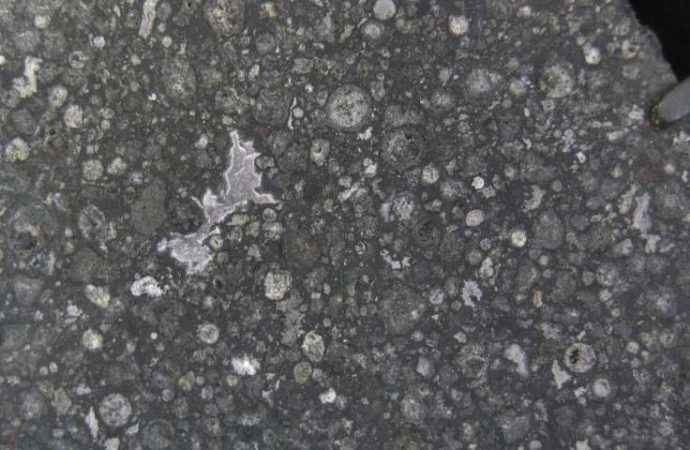A slice from the 4.5-billion-year-old Allende meteorite. This rock was formed along with the solar system.
Chiral molecules can be found in chemically equivalent left-handed (L) and right-handed (D) mirror-image forms – each commonly referred to as an enantiomer. Synthetic sugars and other chiral molecules made in the lab from non-chiral precursors, or any process that does not use asymmetric reagents such as enzymes in biological reactions, tend to make equal amounts (racemic mixtures) of D- and L- enantiomers. However, for reasons that are still largely unknown, biological polymers (e.g., nucleic acids and proteins) use exclusively D-sugars and L-amino acids, respectively. For example, ribose, the sugar found in DNA, is only in the form of D-ribose.
Such an exclusive use of one enantiomer is referred to as homochirality. One group of meteorites, known as carbonaceous meteorites because of a relatively high content of carbon, may hold clues to the origins of homochirality or enantiomer excess in biology. Researchers from NASA have analyzed sugar acids and sugar alcohols in several type 2 carbonaceous meteorites. They found that several sugar acids demonstrate D-enantiomeric excess that becomes more pronounced as the number of carbon atoms increases. Their work appears in the Proceedings of the National Academy of Sciences.
Carbonaceous meteorites are like chemical time capsules: they formed near the very beginning of the solar system ~ 4.6 billion years ago. They therefore contain compounds of extraterrestrial origins including biologically relevant organic compounds. Previous studies on amino acids found in these meteorites showed that most (but not all) are racemic mixtures, which serves as one point of evidence that they are of extraterrestrial origins and not contaminants from Earth. While there have been several studies on meteoritic amino acids, there has only been one study of meteoritic sugar derivatives: in 2001 Cooper et al. examined the Murchison and Murray meteorites for their content of sugar acids and sugar alcohols.
In the current study, Cooper and Rios analyze the enantiomeric ratios of sugar derivatives in several type 2 carbonaceous meteorites. Chiral compounds were 3, 4, 5, and 6-carbon sugar acids, and 4 and 5-carbon sugar alcohols. Additionally, they analyzed several non-chiral compounds.
They found that several sugar acids showed some enantiomeric excess. For example, threonic acid, a 4-carbon acid, was higher in the D-enantiomer by 33-55%. Notably, threonic acid (and other acids) was found in several chondrites with 2-hydroxymethylglyceric acid, a non-biological acid, and therefore, not a contaminant from Earth.
Five-carbon sugar acids were more difficult to study because of their relatively low abundance in the meteorite samples. However, the Murchison meteorite contained enough 5-carbon acids to analyze and compare enantiomeric abundances. Cooper and Rios found that all of the 5-carbon acids showed a greater D enantiomeric excess compared to the 4-carbon acids with one in excess of up to 82%. Notably, this was the trend even for biologically rare acids, such as D-arabinonic acid and lyxonic acid, also indicating that the enantiomeric excesses had extraterrestrial origins.
According to Dr. George Cooper, first author of the study, “Finding excess D-arabinonic acid in a pre-biotic source was significant because, on Earth, arabinonic acid and its parent sugar, arabinose, both contain more of the L enantiomer in the majority of analyzed samples.”
Finally, 6-carbon aldonic acids are in even lower abundance and more difficult to study, although there were some 6-carbon acids found in two of the meteorites. There were not enough samples to do comparison studies, but of the 6-carbon acids analyzed, only D enantiomers were observed.
Because enantiomeric excess is usually an indicator of biological origins (i.e., contamination), Cooper and Rios conducted several studies to further examine whether their findings were due to contamination from Earth or were of extraterrestrial origin. Of particular interest was the composition of meteorite GRA 95229. This meteorite is known to be particularly pristine with little contamination. They found that its 3-carbon and 4-carbon sugar acids have a similar enantiomeric profile to the Murchison meteorite.
Carbon-13/carbon-12 isotope studies and comparisons to soil and dust further indicated that the enantiomeric excess observed in the meteorites were likely not from contamination. Cooper and Rios subjected soil and dust to various tests, including oxidative tests, in an effort to replicate reactions that contaminants from Earth (sugars) may undergo to form oxidative products such as sugar acids.
Dr. Cooper says that these findings may indicate that there was a pre-biotic force that overwhelmingly favored the synthesis of one enantiomer (the D) near the beginning of the solar system. For example, the enantiomeric excess of the sugar derivatives in these samples could be due to simpler precursor molecules that were exposed to radiation, magnetism, or other interstellar forces that have been studied under laboratory conditions.
Source: Phys.org

































Leave a Comment
You must be logged in to post a comment.